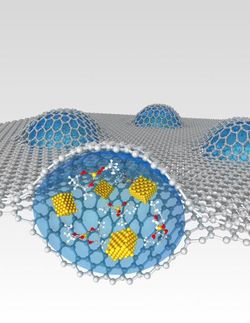ORNL scientists help explain graphene mystery
Nanoscale simulations and theoretical research performed at the Department of Energy's Oak Ridge National Laboratory are bringing scientists closer to realizing graphene's potential in electronic applications.
A research team led by ORNL's Bobby Sumpter, Vincent Meunier and Eduardo Cruz-Silva has discovered how loops develop in graphene, an electrically conductive high-strength low-weight material that resembles an atomic-scale honeycomb.
Structural loops that sometimes form during a graphene cleaning process can render the material unsuitable for electronic applications. Overcoming these types of problems is of great interest to the electronics industry.
"Graphene is a rising star in the materials world, given its potential for use in precise electronic components like transistors or other semiconductors," said Bobby Sumpter, a staff scientist at ORNL.
The team used quantum molecular dynamics to simulate an experimental graphene cleaning process, as discussed in a paper published in Physical Review Letters. Calculations performed on ORNL supercomputers pointed the researchers to an overlooked intermediate step during processing.
Imaging with a transmission electron microscope, or TEM, subjected the graphene to electron irradiation, which ultimately prevented loop formation. The ORNL simulations showed that by injecting electrons to collect an image, the electrons were simultaneously changing the material's structure.
"Taking a picture with a TEM is not merely taking a picture," Sumpter said. "You might modify the picture at the same time that you're looking at it."
The research builds on findings discussed in a 2009 Science paper (Jia et al.), where Meunier and Sumpter helped demonstrate a process that cleans graphene edges by running a current through the material in a process known as Joule heating. Graphene is only as good as the uniformity or cleanliness of its edges, which determine how effectively the material can transmit electrons. Meunier said the ability to efficiently clean graphene edges is crucial to using the material in electronics.
"Imagine you have a fancy sports car, but then you realize it has square wheels. What good is it? That's like having jagged edges on graphene," Meunier said.
Recent experimental studies have shown that the Joule heating process can lead to undesirable loops that connect different graphene layers. The PRL paper provides an atomistic understanding of how electron irradiation from a transmission electron microscope affects the graphene cleaning process by preventing loop formation.
"We can clean the edges, and not only that, we're able to understand why we can clean them," Meunier said.
Most read news
Topics
Organizations
Other news from the department science

Get the analytics and lab tech industry in your inbox
By submitting this form you agree that LUMITOS AG will send you the newsletter(s) selected above by email. Your data will not be passed on to third parties. Your data will be stored and processed in accordance with our data protection regulations. LUMITOS may contact you by email for the purpose of advertising or market and opinion surveys. You can revoke your consent at any time without giving reasons to LUMITOS AG, Ernst-Augustin-Str. 2, 12489 Berlin, Germany or by e-mail at revoke@lumitos.com with effect for the future. In addition, each email contains a link to unsubscribe from the corresponding newsletter.



























































